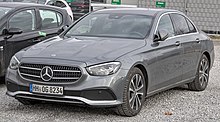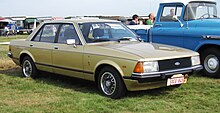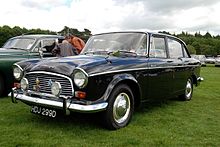Executive car

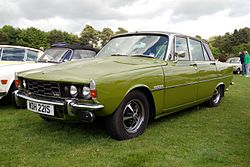
Executive car is a British term for a large car which is equivalent to the European E-segment and American full-size classifications.[1] Executive cars are larger than compact executive cars (and the non-luxury equivalent mid-size cars), and smaller than luxury saloons / full-size luxury sedans.
The term has also been adopted by Euro NCAP, a European organization founded to test for car safety.[2]
Background[]
The term was coined in the 1960s to describe cars targeted at successful professionals and middle-to-senior managers.[3] It was used by businesses as an incentive for employees in senior roles and to exploit Britain and Europe's tax schemes as a company owned vehicle. Early executive cars typically offered engines with displacements of 2.0–3.5 L (122–214 cu in), compared with 1.6–2.4 L (98–146 cu in) for an equivalent sized—but less luxurious—"large family car".[citation needed]
Prior to the 1990s, executive cars were typically sedans, however in recent years they have also been produced in other body styles, such as estates (station wagons), convertibles, coupés, and five-door hatch versions.[4] They typically need to be "comfortable, refined and display some form of driving pleasure" on occasion.[5]
Body styles[]
In general, executive cars are 4-door saloons. Some manufacturers seek to differentiate their offerings by making them as estate variants, or with 5-door hatchback bodies—in particular Rover, Saab, Renault and Citroën formerly have been known to prefer such body styles, with Ford also offering such models through the 1990s, and Audi and BMW have recently offered such body styles for their executive cars. Until the 1990s, some models[which?] were also available as 2-door coupés.
Production by country[]
China[]

One of the first Chinese-built executive cars was the 2006 Roewe 750, based on the Rover 75.[6] In 2012, the Roewe 950 was introduced, which is a re-bodied version of the 2010 Buick LaCrosse.[7]
Several overseas brands have produced long wheelbase versions of cars specifically for the Chinese market, due to the preference Chinese owners have for being driven by a chauffeur.[8] Examples include the "XF L" version of the 2016 Jaguar XF (X260),[9] the "Li" version of the 2017 BMW 5 Series (G30)[10] and other models from Audi, Mercedes-Benz and Volvo.
France[]


In France, executive cars are known as "Grande Routière", a class of comfortable long distance cars that first emerged on the French market in the 1930s.
Peugeot began producing large cars in the early 1900s. Following the Peugeot 601 being discontinued in 1935, Peugeot ceased production of large cars until the Peugeot 604 was introduced in 1975.[11][12][13] The 604 was replaced by the Peugeot 605 in 1989, which in turn was replaced by the Peugeot 607 in 1999. Following the end of the 607's production run in 2010, Peugeot no longer produces any executive cars.
Citroën's first large car was the 1934 Citroën Traction Avant. In 1955, the Traction Avant was replaced by the iconic Citroën DS, which was replaced in 1974 by the Citroën CX and then the 1989 Citroën XM. The XM was discontinued in 2000 and for five years Citroën did not produce an executive car. The 2005 Citroën C6 was produced until 2012, and Citroën has not produced any executive cars since.
Renault entered the executive car segment in 1975 with the Renault 20/30 models. They were replaced, in 1983, by the Renault 25 which featured a fastback rear end. In 1992, the 25 was replaced by the Renault Safrane. The Safrane was replaced by the Renault Vel Satis hatchback in 2002, which in turn was replaced by the Latitude in 2010 and later the Talisman.
Germany[]
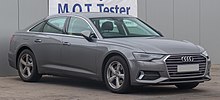
The equivalent class for cars in Germany is "Obere Mittelklasse" (lit. upper-middle class) as defined by the German federal authorities. Luxury cars larger than this are referred to as Oberklasse ("upper class").
Mercedes-Benz has produced large luxury cars since the early 1900s. Following World War II, Mercedes Benz's first all-new models were the Mercedes-Benz W120 executive cars. This lineage continues through to the present and has been marketed as the Mercedes-Benz E-Class since 1993. The Mercedes-Benz CLS-Class four-door fastback was added to the company's model range in 2004, with a shooting brake body style also produced from 2012-2017.
BMW's first large luxury car was the 1936-1941 BMW 326. After a hiatus of 21 years, BMW's next executive car models were the 1962 New Class Sedans. In 1972, the New Class was replaced by the BMW 5 Series, which remains in production today. Over the seven generations of 5 Series, it has been produced in sedan, wagon and four-door fastback body styles.
The first large luxury car produced by Audi was the Audi 100, which was released in 1968. The Audi 100 was replaced by the Audi A6 in 1994, which remains in production today. In 2010, the Audi A7 four-door fastback model range was added.
The Ford Granada is an executive car produced by Ford Europe from 1972-1994.
Italy[]

Fiat's first large luxury car was the Fiat 24-32 HP, which was introduced in 1903. Other large luxury Fiats produced before World War II include the Fiat 510, Fiat 520, Fiat 527 and Fiat 2800. In 1959, the Fiat 1800 and 2100 executive sedans and station wagons were introduced. These models were replaced by the Fiat 2300 in 1961. FIAT's last executive car was the Fiat 130, which was produced from 1969-1977.
Lancia produced several large luxury cars prior to World War II, including the Lancia Lambda, Lancia Artena and Lancia Aprilia. The Lancia Flavia was an executive car began production in 1961 and was replaced by the Lancia 2000 in 1971. The 2000 was replaced by the Lancia Gamma, which was released in 1976. In 1984, the Gamma was replaced by the Lancia Thema, then the Lancia Kappa in 1994. The Lancia Thesis, produced from 2001-2009 is the last executive car produced by Lancia. From 2011-2015, the Chrysler 300 was sold in Europe as the Lancia Thema.[14]
Maserati's first executive is the Maserati Ghibli, which has been in production since 2013.
Japan[]

Toyota has been producing large luxury cars since the 1955 Crown was released. The Crown remains in production today and is currently in its fifteenth generation. In 1991, the Crown-derived Aristo began production, and from 1993 to 2020 had been marketed under Toyota's luxury sub-brand as the Lexus GS.[15]
Nissan's longest-running executive car began production in 1959 as the Prince Gloria, which was later renamed the Nissan Gloria, following the merger of Nissan and Prince. The Gloria was produced for 12 generations until 2004. Another Nissan's executive car was the 1960 Cedric, which was produced until 2004 (although a taxi/fleet version remained in production until 2015). The Cedric was replaced by the 2004 Fuga, also sold as the Infiniti M from 2003 to 2012 and the Q70 since 2012, which presently remains in production.
Mitsubishi began producing executive cars in 1964 with the Debonair. The Debonair was replaced in 1999 by the Proudia, which was discontinued in 2001 and then returned from 2012 to 2016 as a rebadged Fuga.
Mazda's first executive car was the 1969 Luce. In 1991, the Luce was replaced by the Sentia, which was produced until 1999. The Millenia, also sold as the Xedos 9 and the Eunos 800, was produced from 1993 to 2002.
Honda introduced their first executive car, the Legend (sold as the Acura Legend in the United States) in 1985. The Legend was produced until 2012, and then from 2014 until the present.
South Korea[]
A growing number of Asian manufacturers started offering executive cars, such as Kia K8, Hyundai Azera and Genesis G80.
It is believed that the standard of Korean Executive Cars came from the 3rd generation Hyundai Grandeur model launched in 1998. Previous models, Kia Potentia and Hyundai Grandeur, belonged to the large car position and were shopper-driven, but were relegated to owner-driven from the XG model. Afterwards, the launch of Kia Opirus and Daewoo Magnus formed the semi-large car market.
Currently, the semi-large business sedan models sold in the Korean market include Hyundai Grandeur and Kia K7, and the luxury brand is the Genesis G80.
Spain[]
SEAT's only executive car[clarification needed] was the 1963-1973 SEAT 1500, a rebadged version of the FIAT 2300.
Sweden[]

Saab's first executive car was the 1984 Saab 9000, which was produced in sedan and liftback body styles. The 9000 was replaced by the Saab 9-5. In 2010 the second generation of the 9-5 switched to a platform shared with various General Motors models, until Saab went bankrupt in 2012.
Volvo began producing executive cars in 1968 with the Volvo 164. In 1974, the 164 was replaced by the Volvo 260, which was replaced by the Volvo 760 in 1982 and then the Volvo 960 in 1994. The 960 was renamed the S90 (sedan models) and V90 (wagon models) in 1996. The Volvo S80 was released in 1998, which was replaced in 2016 by a new generation of Volvo S90/V90 sedans and wagons that presently remain in production.
United Kingdom[]
Daimler Company produced luxury cars in various sizes starting in the late 1890s. The lineage that led to their executive cars began with the 1923-1929 Daimler 16 and Daimler 16/55 models, which were followed in 1932 by the Daimler Fifteen. The Fifteen was replaced by the 1937 Daimler New Fifteen and then the 1939 Daimler Consort (originally called the "Daimler 2½ Litre"). The Consort was replaced by the 1953-1958 Daimler Conquest. In 1962, the Daimler 2.5 V8 (later renamed the "Daimler V8-250") was released, based on the Jaguar Mark 2. In 1966, the Daimler Sovereign was introduced, based on the Jaguar 420. The Sovereign and V8-250 were produced alongside each other until they both ended production in 1969.
Jaguar began production of executive cars in 1935 with the first of the Jaguar Mark IV models. These were replaced by the 1948-1951 Jaguar Mark V. The Mark V's successor increased in size to the full-size luxury car segment, so the next executive car was the 1955 Jaguar Mark 1. In 1959, the Mark 1 was replaced by the Jaguar Mark 2. In 1963, the Jaguar S-Type was introduced and sold alongside the Mark 2. Both models were replaced by the 1966-1968 Jaguar 420. Following a 30-year hiatus from the executive car market, Jaguar returned in 1998 with the retro-styled S-Type. The S-Type was replaced by the 2007 Jaguar XF (X250) and then the 2015 Jaguar XF (X260), which currently remains in production.
Humber's first executive car was the 1945 Humber Hawk.[16] The Hawk was available with features such as two-tone and metallic paintwork, leather upholstery, wood trimmings and a sunroof. Production of the Hawk, along with the similarly sized Humber Super Snipe and Imperial,[17] ceased when the brand was dissolved in 1967.
Rover entered the executive car market in 1948 with the Rover P3. The P3 was replaced by the Rover P4 in 1949, which was produced until 1964. The 1963 Rover P6 was the next executive car produced by Rover, which was replaced by the Rover SD1 in 1976 (marketed as the Standard 2000 in India).[18] The SD1 was replaced by the 1986 Rover 800 series, which was a jointly developed with the Honda Legend and had a front-wheel drive layout. In 1999, the 800 series was replaced by the Rover 75, which was produced until 2005. The 75 straddled the executive and compact executive categories due to its size, although a long wheelbase version was available.[19]
The first executive car to be badged a Triumph were the 1946-1954 Triumph 1800/2000/Renown models. Triumph's next and final entry to the executive car market was the 1963-1977 Triumph 2000, which was a sales success in Britain.[20]
Ford Europe's first executive car was the 1950 Ford Zephyr. The Zephyr— and related Consul, Zodiac and Executive models— were produced over four generations until 1972. The 1972 Ford Granada was initially built in the United Kingdom before switching to being imported from Germany in 1976. In 1985, the Ford Scorpio was released, being sold in the U.K. as a Ford Granada until 1994.
Vauxhall entered the executive car market with the 1978 Vauxhall Carlton and related Vauxhall Royale/Senator, which were based on the Opel Rekord E. In 1986, the Vauxhall Carlton Mark II switched to the German-built Opel Omega A, which was replaced in 1994 by the Vauxhall Omega (a rebadged version of the Opel Omega B).
United States[]
In the United States, executive cars are referred to as full-sized cars.
Vietnam[]
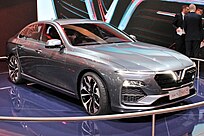
First executive car produced by a Vietnamnese company is the VinFast LUX A2.0, debuted at the 2018 Paris Motor Show. First production started in 2019 and it has made first success in Vietnamese domestic car market.[21]
See also[]
References[]
- ^ "European vehicle categories - EAFO". European Alternative Fuels Observatory - European Commission. Archived from the original on 29 September 2018. Retrieved 1 April 2018.
- ^ "List of Executive Cars". www.euroncap.com.
- ^ Katende, Jude (30 October 2013). "The meaning of executive cars". Daily Monitor. Retrieved 20 August 2019.
- ^ Gibson, Dean (8 January 2018). "Best executive cars 2018". Auto Express. Retrieved 1 April 2018.
- ^ "Top 10 Best mid-size Executive Cars 2019 | Autocar". www.autocar.co.uk. 25 January 2019. Retrieved 21 August 2019.
- ^ Adams, Keith (3 June 2018). "Roewe 750 development story - how the Rover 75 was shipped to China". Aronline.co.uk. Retrieved 30 December 2018.
- ^ Katakis, Manoli (25 April 2012). "New Roewe 950 Is Really Just A Buick LaCrosse". GM Authority. Retrieved 30 December 2018.
- ^ "China is demanding odd long wheelbase cars". Top Gear. 25 April 2016. Retrieved 30 December 2018.
- ^ Jaguar XFL: long-wheelbase XF targets Chinese market Sam Sheehan 25 April 2016
- ^ Adrian Padeanu (20 April 2017). "BMW 5 Series Long Wheelbase Brings Extra Legroom In China". Uk.motor1.com. Retrieved 30 December 2018.
- ^ Autocar, November 1977, p. 17
- ^ Motor, 6 December 1975, p. 2
- ^ Buckley, Martin (January 2007). "Riches To Rags". Classic & Sportscar Magazine. Vol. 25 no. 10. Teddington, Middlesex, UK: Haymarket. p. 148.
- ^ "Lancia & Chrysler European sales figures". Carsalesbase.com. 1 April 2017. Retrieved 30 December 2018.
- ^ "GS 300 (Aristo)". Archived from the original on 8 July 2011. Retrieved 30 December 2018.
- ^ "Detailed specs review of 1945 Humber Hawk offered since mid-year 1945 for Europe North America". www.automobile-catalog.com. Retrieved 24 February 2019.
- ^ "The latest Humber Super Snipe". Motorsportmagazine.com. 30 March 1960. Retrieved 30 December 2018.
- ^ Guinness, Paul (25 June 2015). "Curios: Standard 2000". Honest John. Retrieved 1 April 2018.
- ^ Ward, Garvin (5 June 2002). "Rover 75 LWB". Auto Express. Retrieved 1 April 2018.
- ^ "Triumph 2000 and 2500 (1963 - 1977)". Honest John. 29 August 2013. Retrieved 1 April 2018.
- ^ "VinFast Lux A2.0 được Đại sứ quán Áo dùng làm xe ngoại giao". www.thanhnien.vn. Retrieved 11 November 2020.
- Executive cars
- Car classifications
